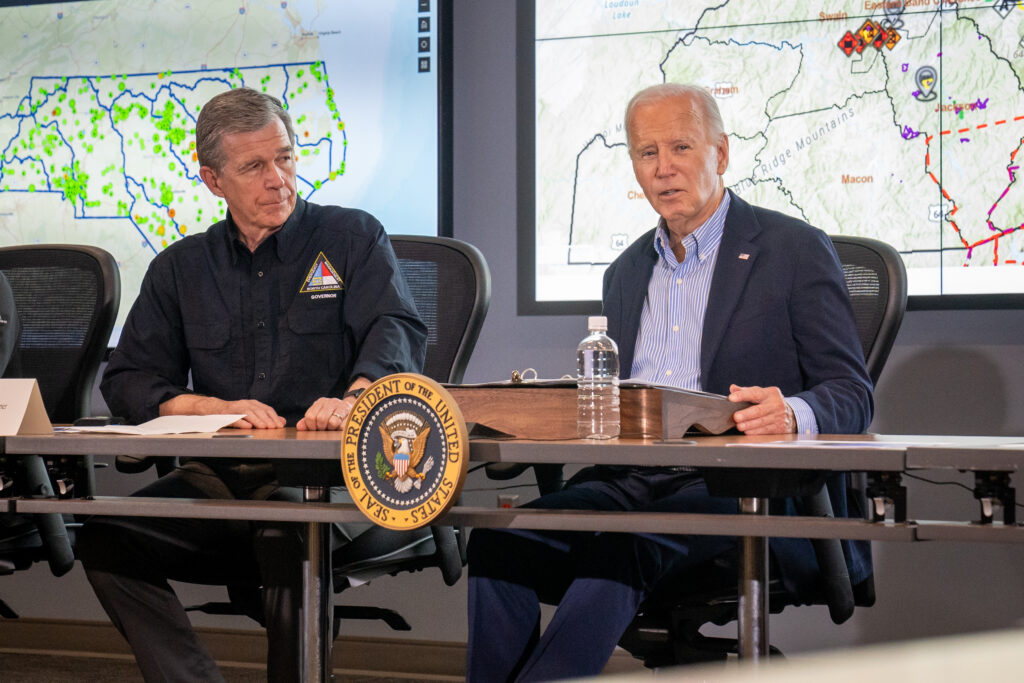Governor Roy Cooper and President Joe Biden hold a briefing on Helene’s impacts at the State Emergency Operations Center following an aerial tour of areas damaged by the hurricane. During the briefing, President Biden announced the approval of 100% FEMA Reimbursement for six months, a significant funding commitment from the federal government. (Pool photo/Paul Barker)
The federal government is providing additional aid to North Carolina as the state recovers from Hurricane Helene, President Joe Biden shared on Wednesday.
The president visited Raleigh for an emergency operations briefing with Gov. Roy Cooper, FEMA administrator Deanne Criswell, and other officials.
Biden said he has accepted Cooper’s request for a 100 percent federal cost share for debris removal and emergency protective measures for six months. This means the federal government will cover costs for the region’s necessary emergency recovery work.
“This will pay for the urgent work you need to clear landslides, to provide shelter, and to provide food and medicine,” Biden said.
The funding would also cover work for addressing the impacts from debris flow, flooding, and removing fallen trees.
Biden directed the U.S. Department of Defense to deploy 1,000 soldiers to assist North Carolina’s National Guard.
The active-duty soldiers are part of an Infantry Battalion Task Force, formed from the XVII Airborne Corps to include members of the 82nd Airborne and other units stationed at Fort Liberty, NC.
FEMA is offering free temporary housing and hotel rooms to eligible residents, he said.
Cooper called the disaster “catastrophic” and “unprecedented,” with destroyed roads and towns wiped off the map.
“An entire region of our state is still in a dangerous situation,” he said.
The death toll from Hurricane Helene has risen to more than 175 people across the Southeast with many individuals still listed as missing.
Cooper expressed gratitude for the speed and quantity of aid provided by Biden and other states around the country.
North Carolina Emergency Management director Will Ray said the office is focused on three things: continuing life safety missions, increasing the speed of commodity distributions, and supporting infrastructure — especially healthcare, power, and communications.
The storm’s severity was enhanced by heavy rainfall that saturated the soil in western North Carolina before Helene made landfall. There were eight confirmed tornadoes and numerous flash flood warnings in the area.
“Our response footprint has grown significantly and we’re grateful for the support, not just from the 22 states that have sent teams to support us, but also from our FEMA team and other members of the federal family,” Ray said.
Between state and federal teams, there are now more than 16,000 personnel operating in the affected areas in order to support local jurisdictions, according to Ray.
Prior to the briefing, Biden took an aerial tour of the impacted communities in western North Carolina.
He took Air Force One into the Greenville-Spartanburg International Airport in South Carolina, before boarding a helicopter to fly over the Asheville area.
This was the least disruptive way for him to survey the damage without getting in the way of rescue and recovery efforts due to the logistics associated with a presidential visit.
Biden said he’s flown over a lot of disaster areas before during his time in office, but was particularly struck by what he saw in western North Carolina and how much of Asheville is underwater.
“Nobody can deny the impact of the climate crisis anymore,” Biden said. “Storms like Helene are getting stronger and stronger.”
The helicopters flew over Biltmore Village, the River Arts district, east Asheville, Swannanoa, Black Mountain, Chimney Rock, and Lake Lure, according to White House press pool reports.
“We saw some homes that were still partially under water,” Politico reporter Lauren Egan wrote in a pool report. “At times it was hard to distinguish between lake and land.”
President Joe Biden visited North Carolina to meet with emergency operations officials on Oct. 2, 2024. (Christine Zhu/NC Newsline)

